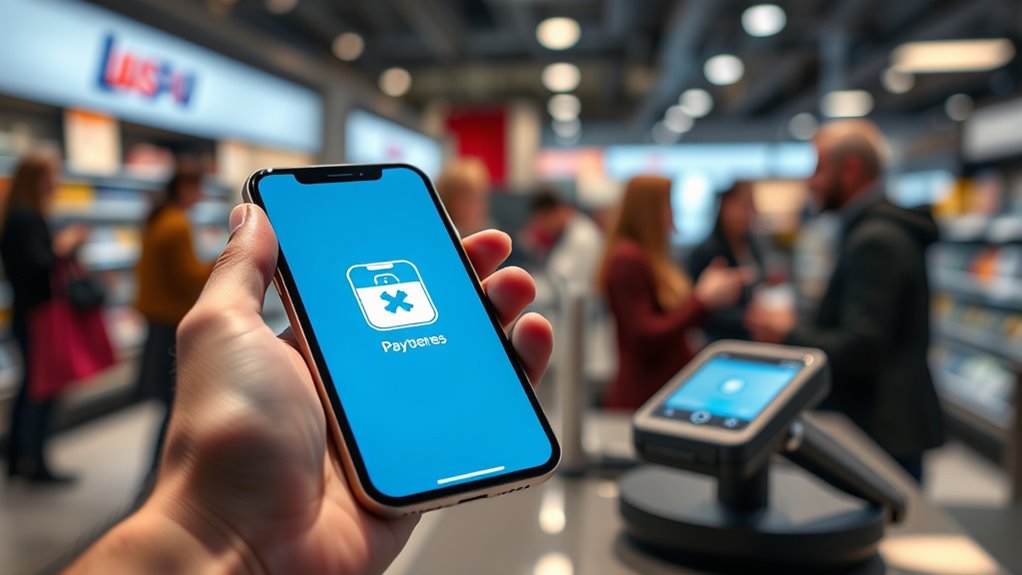Embedded payments let you make purchases directly within apps or websites, so you don’t have to switch to a different platform or enter your details repeatedly. They offer quick, seamless transactions and save you time, while advanced security measures protect your information. To stay safe, only use trusted apps, enable biometric locks, and monitor your accounts regularly. Want to learn how these systems keep your money safe and your experience smooth? Keep exploring.
Key Takeaways
- Embedded payments allow for quick, seamless transactions directly within apps or websites, eliminating redirects to external gateways.
- They enhance user convenience by enabling faster purchases and simplifying the overall shopping experience.
- Security is prioritized through encryption, tokenization, multi-factor authentication, and device security features.
- Users should only use trusted platforms, keep their devices secure, and monitor transactions regularly for suspicious activity.
- Balancing convenience with security practices helps consumers enjoy fast payments while minimizing financial risks.

Have you noticed how many of your transactions now happen seamlessly within apps or websites? It’s almost effortless—no need to fumble for cash or swipe a card. This convenience is the backbone of embedded payments, which integrate payment options directly into your favorite platforms. Instead of redirecting you to a separate payment gateway, these systems allow you to pay instantly without interrupting your shopping experience. It’s a game-changer for transaction convenience, making every purchase quick and hassle-free. Whether you’re buying a coffee, booking a ride, or subscribing to a service, embedded payments streamline the process, saving you time and effort.
But as you enjoy this seamlessness, it’s natural to wonder about security concerns. When your payment details are embedded within an app or website, you might worry about how safe your information truly is. Rest assured, reputable companies implement advanced security measures—encryption, tokenization, and multi-factor authentication—to protect your data. These technologies ensure that your bank or card details are not stored directly on the platform but are instead replaced with secure tokens, reducing the risk of theft or misuse. Still, it’s wise to stay vigilant. Only use trusted apps and websites, keep your device’s security features up to date, and monitor your transactions regularly for any suspicious activity.
Embedded payments also rely heavily on your device’s security features. For example, biometric authentication like fingerprint scans or facial recognition adds an extra layer of protection, making unauthorized access more difficult. This integration enhances transaction security without sacrificing convenience. You get the best of both worlds: quick payments with peace of mind that your information remains safe. Plus, many platforms now offer real-time alerts and purchase histories, helping you track your spending and spot any irregularities early.
As you adopt embedded payments, it’s important to understand that they’re designed to be user-friendly but also secure. The goal is to make your transactions as smooth as possible without compromising your privacy or safety. While no system is completely invulnerable, the combination of robust security practices and your own cautious habits considerably reduces potential risks. Remember, the convenience of embedded payments isn’t worth sacrificing security—so always choose trusted providers, enable security features on your devices, and stay aware of your financial activity. By doing so, you can enjoy faster, easier transactions while keeping your financial information safe and secure. Additionally, understanding how financial misconduct can impact your financial stability underscores the importance of secure payment methods.
Frequently Asked Questions
How Do Embedded Payments Protect My Financial Information?
Embedded payments protect your financial information by using encryption protocols, which secure your data during transactions, making it unreadable to hackers. Additionally, robust fraud detection systems monitor activity for suspicious behavior, preventing unauthorized access. These measures work together to keep your financial details safe, giving you peace of mind when making purchases or payments seamlessly within apps or websites.
Can I Use Embedded Payments Internationally?
Yes, you can use embedded payments internationally. They facilitate cross-border transactions smoothly, allowing you to pay in different currencies. When making international purchases, embedded payments handle currency exchange automatically, often offering competitive rates. Just be aware that some providers might charge additional fees for currency conversion or cross-border transactions. Always check the terms before using embedded payments abroad to guarantee you understand any extra costs involved.
What Are the Common Security Risks With Embedded Payments?
Did you know that 43% of cyberattacks target payment systems? Embedded payments pose security risks like fraud, data breaches, and unauthorized transactions. To protect yourself, rely on robust security protocols and fraud prevention measures offered by providers. Always stay vigilant, use strong authentication methods, and keep your software updated. Being proactive helps minimize risks and keeps your financial information safe during embedded payment transactions.
How Do Embedded Payments Affect My Privacy?
Embedded payments can impact your privacy by sharing your data with merchants and third parties, which may raise concerns about data privacy. You might not always have full control over what information is collected or how it’s used. By actively managing your consent, you can decide what data to share, helping protect your privacy. Always review privacy policies and consent options to stay informed and safeguard your personal information.
Are There Additional Fees for Using Embedded Payment Options?
While embedded payment options often seem seamless, you might notice some transaction fees or hidden costs. These fees can vary depending on the platform or merchant, so it is crucial to read the fine print. Sometimes, using embedded payments may be free, but extra charges could appear for specific features or faster processing. Always check for any additional fees upfront to avoid surprises and make informed decisions.
Conclusion
Understanding embedded payments helps you stay in control and avoid surprises. You might think they’re too complex or hidden, but knowing how they work empowers you to make smarter choices. By staying informed, you won’t get caught off guard by unexpected charges or fees. Embrace these technologies confidently—when you understand them, they become tools that serve you better, making your transactions smoother and more transparent every time.









